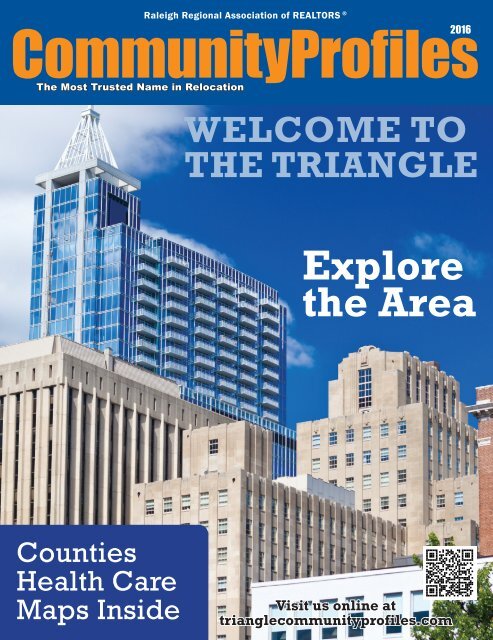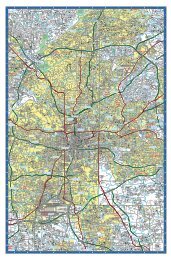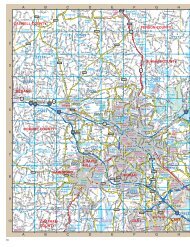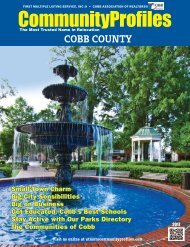Create successful ePaper yourself
Turn your PDF publications into a flip-book with our unique Google optimized e-Paper software.
Raleigh Regional Association of REALTORS ®<br />
2016<br />
CommunityProfiles<br />
The Most Trusted Name in Relocation<br />
WELCOME TO<br />
THE TRIANGLE<br />
Explore<br />
the Area<br />
Counties<br />
Health Care<br />
Maps Inside<br />
Visit us online at<br />
trianglecommunityprofiles.com<br />
<strong>triangle2016</strong>.indd 1<br />
2/22/16 10:12 PM
When a<br />
dinner party<br />
at your place<br />
is considered<br />
an event,<br />
you’re living the drees.<br />
For decades, Drees’ commitment to style, craftsmanship and quality has been<br />
reflected in every detail. From our customizable floor plans to the hundreds of<br />
choices at our Design Center, you’ll have the freedom to create a home to perfectly<br />
fit your life. And with DreeSmart Conservation Innovations, your Drees home will<br />
be as energy efficient as it is unique.<br />
Build a home of your own and start living the drees.<br />
<strong>triangle2016</strong>.indd 2<br />
2/22/16 10:12 PM
CHAPEL HILL<br />
Briar Chapel<br />
Single Family Homes from the $400s<br />
(919) 903-8409<br />
Claremont<br />
Single Family Homes from the $500s<br />
(919) 803-4552<br />
DURHAM<br />
Brightleaf at the Park<br />
Single Family Homes from the $320s<br />
(919) 596-9513<br />
Oaks at Lyon’s Farm<br />
Single Family Homes from the $400s<br />
(919) 908-9333<br />
HILLSBOROUGH<br />
Corbin Creek Woods<br />
Single Family Homes from the $420s<br />
(919) 309-1125<br />
ORANGE COUNTY<br />
Cabe Crossing*<br />
Single Family Homes from the $500s<br />
(919) 309-1125<br />
Model Hours:<br />
Mon-Sat 11-6 & Sun 12-6<br />
*By appointment only<br />
Prices subject to change.<br />
© 2014 The Drees Company. All rights reserved. 150867<br />
Visit DreesHomes.com today.<br />
Build a Customized Drees Home Anywhere.<br />
Whether you already own a lot, need help finding a site,<br />
or have a particular property in mind, Drees makes it<br />
easy to build a customized home anywhere you want<br />
to live throughout the Triangle.<br />
• Firm contract pricing<br />
• Save thousands with no construction loan<br />
• One stop selections process<br />
• Formal follow-up program<br />
Priced from the $300s to $600s, plus home site<br />
DreesOnYourLot.com<br />
For more information call (866) 246-3135<br />
<strong>triangle2016</strong>.indd 3<br />
2/22/16 10:12 PM
mover essentials &<br />
featured info<br />
By Camie Williams<br />
Welcome to the Triangle!<br />
State of North Carolina<br />
Information<br />
ncgov.com<br />
Vehicle Tags and<br />
Driver’s License<br />
(919) 715-7000<br />
ncdot.org<br />
Voter Registration<br />
(919) 733-7173<br />
ncsbe.gov<br />
City of Raleigh<br />
(919) 996-3000<br />
raleighnc.gov<br />
City of Durham<br />
(919) 560-3000<br />
durhamnc.gov<br />
City of Chapel Hill<br />
(919) 968-2743<br />
ci.chapel-hill.nc.us<br />
Greater Raleigh<br />
Chamber of Commerce<br />
(919) 664-7000<br />
raleighchamber.org<br />
Greater Durham<br />
Chamber of Commerce<br />
(919) 328-8700<br />
durhamchamber.org<br />
Chapel Hill-Carrboro<br />
Chamber of Commerce<br />
(919) 967-7075<br />
carolinachamber.org<br />
CommunityProfiles<br />
Louis Wieland<br />
Wieland Communications, Inc.<br />
301 Bombay Lane,<br />
Roswell, GA 30076<br />
Phone: (678) 319-4433<br />
Cell: (404) 441-0719<br />
Email: lou@communityprofiles.info<br />
>><br />
+<br />
Welcome to the Triangle …. The region described as “the flower of the Carolinas” more than 400 years ago that has<br />
blossomed into one of the most desirable business and residential communities in the country.<br />
Explorer Sir Walter Raleigh called North Carolina “the goodliest land under the cope of heaven.” More than 400 years<br />
later, the little slice of heaven that bears the explorer’s name has transformed from an agrarian community to one of the<br />
most prominent high-tech business centers in the country, as a member of the famed Research Triangle. Tradition also<br />
reigns in the “City of Oaks,” which has been the capital of North Carolina since it was established in 1792.<br />
Raleigh is one of very few cities designed to be a capital city, with streets laid out in an axis, with four public squares<br />
and one central square, a pattern that has served it well for the recent growth that has taken the population to 431,746,.<br />
It is the 42nd largest city in the country. Its neighbor and partner Durham adds nearly 250,000 more residents, helping<br />
to add up to more than 2 million living in the Research Triangle of Raleigh-Durham-Chapel Hill.<br />
That 19th century establishment of Raleigh-Durham-Chapel Hill as a mecca for higher education set the stage for<br />
the Triangle’s prominence in the national economy during the next century. Much of the region’s modern history was<br />
determined in 1959 by the opening of Research Triangle Park, one of the largest research parks in the world located just<br />
outside of Raleigh. Forging a connection between Raleigh’s North Carolina State University, Durham’s Duke University<br />
and Chapel Hill’s University of North Carolina, the 7,000-acre high-tech research and development center not only<br />
became home to nearly 200 companies and provided jobs to 50,000 workers, but it created an economic engine that<br />
drove the entire region.<br />
Raleigh is No. 1 on Forbes’ 2014 list of best places for business and careers, No. 12 in education and No. 25 in job<br />
growth. It is also the No. 3 American Boomtown by Bloomberg. Durham has recently been hailed among the Top 10 Tech<br />
Towns by Wired magazine and is No. 6 America’s Smartest List by Forbes. Cary, the third largest city in the region, has<br />
made Money Magazine’s Best Places to Live list, as has Chapel Hill.<br />
The city is home to a variety of businesses from varied industries, including banking/financial services; electrical,<br />
medical, electronic and telecommunications equipment; food processing; and pharmaceutical. Local headquarters<br />
include BB&T Insurance Services, Capitol Broadcasting Company, Carquest, First Citizens BancShares, Golden Corral,<br />
Martin Marietta Materials and software company Red Hat.<br />
But it isn’t all business in the Triangle, as evidenced by its accolades as No. 3 least stressed out city (Raleigh) by CNN<br />
Money in 2014, No. 1 Fastest Growing City for Retirees (Raleigh) in 2013 and the No. 3 Most Optimistic U.S. Metro area<br />
according to the Gallup-Healthways Well-Being Index in 2012.<br />
In the Triangle, the arts and cultural activities are an important part of life. The North Carolina Museum of Art is<br />
hailed as one of the best collections between Washington D.C. and Atlanta, while the North Carolina Museum of Natural<br />
Sciences is the largest museum of its kind in the Southeast, with live programs, educational films and permanent<br />
and special exhibits. The North Carolina Museum of History, an affiliate of the Smithsonian Institute completes the<br />
trifecta of much lauded museum offerings in town. In Durham, the Scrap Exchange is the largest nonprofit creative<br />
reuse arts center in the country. Those museums, a mix of art galleries,10 local arboretums and botanical gardens and<br />
other offerings attract more than 13 million visitors l to the Triangle each year. Many arrive through Raleigh-Durham<br />
International Airport.<br />
Durham’s food scene has reached acclaim, with Southern Living calling it “The Tastiest Town in the South” and Bon<br />
Appétit giving it the No 1 ranking as America’s Foodiest Small Town.<br />
Basketball isn’t just a sport in the Triangle. It’s a legend. Not only are Raleigh, Durham and Chapel Hill home to the<br />
premiere higher education institutions in the state, but those colleges are also some of the most competitive basketball<br />
towns in the nation.<br />
The Blue Devils men’s basketball team at Durham’s Duke University is one of the winningest programs in NCAA<br />
history, under the leadership of legendary coach Mike Krzyzewski. The team has brought home the national championship<br />
four times. The Tarheels at the University of North Carolina in Chapel Hill and the Wolfpack at NC State in Raleigh are<br />
also major competitors in the Atlantic Coast Conference, creating a fun rivalry among the towns in the Triangle. And the<br />
Wolfpack is one of the most storied teams in women’s basketball history.<br />
CommunityProfiles<br />
atlantacommunityprofiles.com • charlottecommunityprofiles.com • dallascommunityprofiles.com • denvercommunityprofiles.com<br />
houstoncommunityprofiles.com • jacksonvillecommunityprofiles.com • nashvillecommunityprofiles.com<br />
northernvirginiacommunityprofiles.com • northgeorgiacommunityprofiles.com • orlandocommunityprofiles.com<br />
trianglecommunityprofiles.com • seattlecommunityprofiles.com • stlouiscommunityprofiles.com • tampacommunityprofiles.com<br />
PERMISSIONS: Material in this publication may not be reproduced without permission. Requests for permission should be directed to Wieland Communications, Inc. Dept.<br />
of Righs and Permissions, 301 Bombay Lane, Roswell, GA 30076. Information in this publication is based on authoritative date available through local sources at the time<br />
of printing and is subject to change without notice. Every effort has been made to ensure that all information is accurate. However, some information is subject to change<br />
after the magazine’s publication. We regret any inconvenience this may create for our readers. We welcome reader input and suggestions.<br />
@2014 Wieland Communications, Inc.<br />
ALL RIGHTS RESERVED<br />
<strong>triangle2016</strong>.indd 4<br />
2/22/16 10:12 PM
Chatham County<br />
chathamnc.org<br />
Chatham County was formed in 1771 from Orange County. It was named for William<br />
Pitt, first Earl of Chatham, who served as British Prime Minister from 1766 to 1768<br />
and opposed harsh colonial policies. In 1907, parts of Chatham County and Moore<br />
County were combined to form Lee County.<br />
Chatham is one of the fastest-growing counties in North Carolina and part of<br />
the famous Research Triangle region. Its quality of life attracts a diverse resident<br />
workforce and innovative companies that value local amenities such as strategic<br />
location, abundant natural resources, and vibrant communities.<br />
Whether one visits for just one day or books several nights, there is a bounty<br />
of sights and activities to appeal to a variety of ages and diverse interests. Explore<br />
Jordan Lake, Fearrington Village, bed and breakfasts, native flora, great golf, food<br />
tours, wineries and wildlife sanctuary tours. There are endless opportunities for<br />
birding, biking, dining, hiking, shopping and more.<br />
Population: 65,976 County Seat: Pittsboro<br />
Square Miles: 709 Median Income: $47,761<br />
Millage Rate: 0.6219<br />
Municipalities: Cary, Goldston, Pittsboro, Siler City, Albright, Baldwin, Bear<br />
Creek, Cape Fear, Center, Gulf, Hadley, Hickory Mountain, Matthews,<br />
New Hope, Oakland, Williams, Census-designated places Bennett,<br />
Fearrington Village, Gulf, Moncure, Unincorporated communities Bear<br />
Creek, Bonlee, Brickhaven, Bynum, Carbonton, Corinth, Crutchfield<br />
Crossroads, Haywood, Silk Hope, Wilsonville<br />
Caswell County<br />
caswellcountync.gov<br />
Caswell County was formed from a section of Orange County in 1777. It was named<br />
for Richard Caswell, Governor of North Carolina from 1776 to 1780, Leasburg was<br />
the first county seat. In 1792, roughly the eastern half of Caswell County became<br />
Person County. After the division, the Caswell center of government was moved to<br />
the centrally-located community of Caswell Court House,<br />
Yanceyville is home to an antebellum courthouse designed by William Percival<br />
and more than 20 buildings built between 1830 and the Civil War. The county<br />
hosts two major festivals a year: the “Bright Leaf Hoedown” and the “Spring Fling.”<br />
The Hoedown is a one-day outdoor event held in late September in Yanceyville. It<br />
features local food vendors, live entertainment, crafts and nonprofit organizations,<br />
usually drawing more than 5,000 guests. The Spring Fling is a two-day event held<br />
on a weekend in late April or early May on the grounds of the Providence Volunteer<br />
Fire Department.<br />
The Caswell County Parks and Recreation Department offers a full slate of<br />
outdoor sports and activities, especially for children. Every May, the Caswell County<br />
Historical Association holds the annual Heritage Festival celebrating the county’s<br />
history through living history reenactments, tours, games, vendors and live music.<br />
The Cherokee Scout Reservation is south of Yanceyville near Farmer’s Lake.<br />
Population: 23,217 County Seat: Yanceyville<br />
Median Income:$38,387 Millage Rate: 0.659<br />
Square Miles: 428<br />
Municipalities: Milton, Yanceyville<br />
Franklin County<br />
franklincountync.us<br />
Franklin County was formed in 1779 from the southern half of Bute County. It is<br />
named for one of America’s founding fathers, Benjamin Franklin and is a part of<br />
the Research Triangle. Its residents enjoy a relaxed lifestyle with access to the<br />
metropolitan amenities of Raleigh, the state capital, Durham and Chapel Hill.<br />
For the sports fan there is major league hockey and minor league baseball. For those<br />
with a curious nature there is an abundance of art, science and history museums,<br />
the North Carolina Symphony, the American Dance Festival and Broadway touring<br />
performances.<br />
If outdoor adventures and fresh mountain air call to you, Franklin is situated in<br />
the foothills of the Great Smoky Mountains. You don’t have to venture far to find<br />
beautiful scenery, hiking, gem mining, fishing, history, and residents that will make<br />
visitors feel right at home.<br />
Population: 61,475 County Seat: Louisburg<br />
Median Income: $43,433 Millage Rate: 0.8725<br />
Square Miles: 495<br />
Municipalities: Bunn, Centerville, Franklinton,<br />
Louisburg, Wake Forest, Youngsville<br />
Person County<br />
personcounty.net<br />
In Person County residents care about the past and the future, though they are<br />
most interested in the opportunities offered up by the present.<br />
Located to the north of the bustling urban areas of Raleigh, Durham, and Chapel<br />
Hill, you’ll find the friendly confines of Person County. The area offers rural scenery<br />
and small-town hospitality. Nestled among gently rolling hills sprinkled with forests<br />
and farms, Person offers residents and visitors a chance to enjoy a gentler pace<br />
with options for plenty of activities.<br />
There is much to experience in Person County. From sports, theater, dance,<br />
<strong>triangle2016</strong>.indd 5<br />
2/22/16 10:12 PM
concerts, comedy and karaoke to the fun of bowling, skating, movies, state-of theart<br />
games and a fast-action dragway, your only problem will be having a long enough<br />
vacation to take in all the fun.<br />
And when you’re planning your trip make sure you check the calendar ahead of<br />
time for festivals and other special events.<br />
For baseball fans in particular there’s the Enos Slaughter Exhibit. Slaughter<br />
played in the Major Leagues during the 1930s, ’40s and ’50s. He was inducted into<br />
the Baseball Hall of Fame in 1985. Slaughter played for the St. Louis Cardinals, the<br />
New York Yankees and the Milwaukee Braves (before the team moved to Atlanta).<br />
During his career, Slaughter played in five World Series -- on the winning side four<br />
times.<br />
Population: 39,268 County Seat: Roxboro<br />
Median Income: $22,453 Millage Rate: 0.70<br />
Square Miles: 404<br />
Municipalities: Roxboro, CDP: Rougemont, Townships: Allensville, Bushy<br />
Fork, Cunningham, Flat River, Holloway, Mount Tirzah, Olive Hill, Roxboro,<br />
Woodsdale<br />
Granville County<br />
granvillenc.govoffice2.com<br />
Granville County was formed in 1746, named for John Carteret, second Earl<br />
Granville. As heir to one of the eight original Lords Proprietors of the Province of<br />
Carolina, he claimed one-eighth of the land granted in the charter of 1665. In 1752,<br />
parts of Granville County, Bladen County, and Johnston County were combined to<br />
form Orange County. In 1764, the eastern part of Granville County became Bute<br />
County. Finally, in 1881, parts of Granville County, Franklin County, and Warren<br />
County were combined to form Vance County.<br />
Granville County today boasts good people and small-town atmospheres, just<br />
minutes from the Triangle, and opportunities for business and personal growth.<br />
Oxford’s oldest jailhouse, built in 1795, has been converted into a museum<br />
dedicated to the collection and display of artifacts portraying Granville County’s<br />
history. While the iron-barred cells are gone, the flavor of the earlier edifice is<br />
present, augmented by new exhibits that include the Oxford-China Connection.<br />
Today Granville is known for its small-town ambiance, history, colonial architecture<br />
and varied recreational activities. Situated just north of Raleigh-Durham, it’s a<br />
short drive from the big city, located right off of I-85 and only 20 minutes from the<br />
Virginia state line. The county’s annual events include the North Carolina Hot Sauce<br />
Contest in Oxford, the Creedmoor Music Festival and the always entertaining Butner<br />
Chicken Pickin’ and many more.<br />
Population: 60,436 County Seat: Smithfield<br />
Median Income: $44,544<br />
Millage Rate: 0.8250 Square Miles: 796<br />
Municipalities:Creedmoor, Oxford. Towns: Butner, Stem, Stovall.<br />
Townships:Brassfield, Dutchville, Fishing Creek, Oak Hill, Oxford.<br />
Harnett County<br />
harnett.org<br />
Harnett County was formed in 1855 from land given by Cumberland County. It was<br />
named for American Revolutionary war soldier Cornelius Harnett, who was also a<br />
delegate to the Continental Congress.<br />
The first settlers came in the mid 1720s, and were followed by the Highland<br />
“Scots.” The Scots settled in the foothills and after their defeat by the British, the<br />
Scots came up the Cape Fear River in ever-increasing numbers and settled in<br />
western Harnett County. The British also settled along the banks of the Cape Fear<br />
River in the coastal area, generally from Erwin to Wilmington.<br />
One of the last battles of the Civil War occurred in Averasboro near Erwin. General<br />
Sherman’s army, on its march to the sea, defeated the army of General Hardee and<br />
proceeded eastward. The centennial celebration of that event was held at the site<br />
of the battlefield in 1965. Only after 1880, did the population begin to establish<br />
itself in urban rather than rural areas. The municipalities of Erwin, Coats, Dunn and<br />
Lillington evolved into trading/commercial areas.<br />
Today more than one-fifth of the population resides in towns or villages.<br />
Agriculture and agricultural products are the leading source of income in the county.<br />
The preponderance of the population is either engaged directly in agriculture or<br />
derives a major portion of its income from the economy created by agricultural<br />
pursuits. According to the U.S. Census Bureau, the county has a total area of 601<br />
square miles (1,556.6 sq km), of which 595 square miles (1,541.0 sq km) is land<br />
and six square miles (15.5 sq km) (1.05%) is water.<br />
According to Harnett.org: “Harnett County is now moving into the industrial<br />
development phase. Community planning is being undertaken on an unprecedented<br />
scale and new leadership is emerging which holds promise of broadening the<br />
4<br />
county’s economic base. The western and southwestern portion of Harnett County<br />
could easily become the playground of East-Central Carolina. The terrain, the<br />
geological character and its proximity to large and growing metropolitan areas place<br />
this portion in an excellent competitive position. History is made by people, and the<br />
people of Harnett County accept the challenge that tomorrow shall hold unlimited<br />
opportunity.”<br />
Population: 122,135 County Seat: Lilington<br />
Median Income: $44,242<br />
Millage Rate: 0.75 Square Miles: 601<br />
Municipalities: Angier, Coats, Dunn, Erwin, Lilington<br />
Lee County<br />
leecountync.gov<br />
Lee County was established in 1907, carved from portions of Moore and Chatham<br />
counties. The county, named for CSA hero Robert E. Lee, is North Carolina’s 98th<br />
county. Situated in the geographic center of the state, it straddles the fall line<br />
dividing the Piedmont and the Coastal Plain.<br />
The city of Sanford, named for Col. Charles Ogburn Sanford, is the county seat.<br />
While the area had a significant population of American Indians, more is known<br />
about the history of then-immigrant settlers. Europeans (predominantly Highland<br />
Scots) and Africans started arriving in the middle part of the 1700s. Presbyterians<br />
were the greatest in sheer number with Quaker, Baptist and Methodist churches<br />
developing later.<br />
In those days its commerce concentrated on agriculture, naval stores, and iron.<br />
Some transportation was land-based but the businesses in the community were<br />
able to take advantage of the Cape Fear and Deep Rivers.<br />
Around the time of the Civil War, the first commercial exploration of the area’s coal<br />
veins was begun. During the war, the coal was transported via railroad, which had<br />
been built by slaves and immigrant Irish laborers.<br />
The County of Lee was formed through a bill passed by the General Assembly in<br />
1907. The county enjoyed rapid growth thanks to tobacco harvesting, brownstone<br />
quarrying, furniture making, brickworks and later textiles. By 1930 the county<br />
population numbered 13,400 people. After World War II, in 1947, the cities of<br />
Sanford and Jonesboro merged.<br />
Population: 59,715 County Seat: Sanford<br />
Median Income: $45,343<br />
Millage Rate: 0.72 Square Miles: 259<br />
Municipalities: Broadway, Cumnock, Sanford, Lemon Springs, Tramway<br />
Moore County<br />
moorecountync.gov<br />
The first residents of what would become Moore County were Native Americans. The<br />
first European settlers came about 1739. As time went by more settlers -- English,<br />
Ulster Scots, and Germans -- moved into the area, traveling down from Pennsylvania<br />
or up the Cape Fear River valley from Wilmington. The greatest concentration was on<br />
the fertile area along the Deep River in northern Moore County. By the mid-1750s,<br />
the area was sparsely but evenly settled.The American Revolution slowed the influx<br />
of settlers. In 1783 Moore became a county, named for Alfred Moore of Brunswick,<br />
a militia colonel in the Revolution, and later a Justice of the Supreme Court of the<br />
United States. In the post-war years the area recovered from the effects of the<br />
conflict and began to prosper. Schools were built and several industries established.<br />
The Civil War put an end to all progress and after the war, Moore had a long<br />
struggle to recovery. But, in the 1870’s, the Raleigh and Augusta Railroad came<br />
through the Sandhills, providing a means to ship the products of the pine forests.<br />
Little towns began showing up. During the 1880s, yet another industry developed<br />
as the area became a mecca for those with various health problems who needed<br />
an abundance of fresh air and mineral water. An increase in population followed.<br />
Moore County is in the south central region of the state and is bordered by<br />
Cumberland, Harnett, Hoke, Scotland, Richmond, Montgomery, Randolph,<br />
Chatham, and Lee counties. The present area is 705.49 square miles (451,514<br />
acres).<br />
The County of Moore is governed by a five-member Board of Commissioners<br />
elected in a partisan election by qualified voters of the entire County for overlapping<br />
four-year terms of office. The elections are held in November of even-numbered<br />
years and the Board is formed on the first Monday of December.<br />
The County is divided into ten townships for historical and administrative<br />
purposes, with no legal or governmental authorities. The townships, and areas in<br />
square miles, are as follows: Bensalem, 97.48; Carthage, 98.14; Deep River, 43.16;<br />
Greenwood, 44.95; Little River, 33.72; Mineral Springs, 101.33; McNeill, 76.68;<br />
Ritter, 54.24; Sandhills, 81.74; and Sheffield, 74.05.<br />
<strong>triangle2016</strong>.indd 6<br />
2/22/16 10:12 PM
Population: 90,302 County Seat: Carthage<br />
Median Income: $48,238<br />
Millage Rate: 0.465 Square Miles: 706<br />
Municipalities: Aberdeen, Cameron, Carthage, Foxfire, Jackson<br />
Springs, Pinebluff, Pinehurst, Robbins, Seven Lakes, Southern<br />
Pines, Taylortown, Vass, West End, Whispering Pines.<br />
Wake County<br />
wakegov.com<br />
Wake County was formed in 1771 from parts of Cumberland County, Johnston<br />
County, and Orange County. Wake lost some of its territory through the formation<br />
of other counties. Parts were included in Franklin County in 1787, and in Durham<br />
County in both 1881 and 1911.<br />
During the colonial period of North Carolina, the state capital was New Bern.<br />
For several years during and after the Revolutionary War there was no capital, and<br />
the General Assembly met in various locations. Fayetteville was the state capital<br />
from 1789 to 1793, when Raleigh became the permanent state capital. Raleigh<br />
became both the state capital and the new seat of Wake County.<br />
The Battle at Morrisville Station was fought in the spring of 1865 in Morrisville.<br />
It was the last battle of the Civil War between the armies of Major General William<br />
T. Sherman and General Joseph E. Johnston.<br />
The county is governed by the Wake County Board of Commissioners, a<br />
seven-member board. Terms are staggered so that every two years, three or four<br />
commissioners are up for election.<br />
It is one of the counties in North Carolina not required to have election laws<br />
approved by the Department of Justice. Forty of the 100 counties in North Carolina<br />
must have their election laws reviewed by the Department of Justice due to the<br />
Voting Rights Act.<br />
According to the U.S. Census Bureau, the county has a total area of 857 square<br />
miles (2,220 sq km), of which 832 square miles (2,150 sq km) is land and 25<br />
square miles (65 sq km), or 2.95%, is water.<br />
Wake County is located in the northeast central region of North Carolina, where<br />
the North American Piedmont and Atlantic Coastal Plain regions meet. Most of<br />
Wake features gentle hills that slope toward the state’s flat coastal plain. Bodies of<br />
water that are located in Wake County include Lake Crabtree, Crabtree Creek, Lake<br />
Johnson, the Neuse River, and portions of Falls Lake and Jordan Lake.<br />
Population: 952,151 County Seat: Raleigh<br />
Median Income: $61,347<br />
Millage Rate: 0.534 Square Miles: 857<br />
Municipalities: Raleigh, Cary, Apex, Wake Forest, Garner, Holly Springs,<br />
Morrisville, Fuquay-Varina, Knightdale, Wendell, Zebulon, Rolesville.<br />
Durham County<br />
dconc.gov<br />
The Native American influence in the area of Durham county runs deep. Durham<br />
is thought to be the site of an ancient Native American village named Adshusheer.<br />
The Great Indian Trading Path is traced through the area, and Native Americans<br />
established settlement sites, transportation routes, and eco-friendly patterns of<br />
natural resource use.<br />
During the 1700s, Scots, Irish and English colonists settled on land granted to<br />
John Carteret, Earl of Granville. Prior to the American Revolution, settlers in the area<br />
were involved in the “War of Regulators.” Reportedly militia cut Cornwallis Road<br />
through this area in 1771 to quell the rebellion.<br />
During the period between the Revolutionary and Civil Wars, plantations were built.<br />
Due to a disagreement between plantation owners and farmers, North Carolina<br />
was the last state to secede from the Union. Locals fought in several regiments<br />
and 17 days after Lee surrendered at Appomattox, Union General Sherman and<br />
Confederate General Johnston negotiated the end of the Civil War at Bennett Place<br />
in Durham.<br />
Yankee and Rebel soldiers celebrated together with Brightleaf tobacco, which<br />
spawned the ultimate success of Washington Duke and his family. That inspired<br />
other Durham developments. The first mill to produce denim and the world’s largest<br />
hosiery maker were established during this time.<br />
In 1887, Trinity College moved from Randolph County to Durham. Washington<br />
Duke and Julian Carr donated money and land. Following a $40 million donation by<br />
the Duke family Trinity was renamed Duke University in 1924. In 1910, Dr. James<br />
E. Shepard founded North Carolina Central University, the nation’s first publiclysupported<br />
liberal arts college for African-Americans.<br />
In the middle of the 20th century what is now the world’s largest universityrelated<br />
research park and namesake for the vast Triangle region was formed.<br />
Research Triangle Park is encompassed on three sides by the City of Durham, with<br />
a small portion now spilling into Wake County toward Cary and Morrisville. Close to<br />
140 companies, including Bayer, GlaxoSmithKline, IBM, Underwriters Laboratories,<br />
and agencies such as the EPA, employ more than 45,000.<br />
Population: 279,641 County Seat: Durham<br />
Median Income: $65,700<br />
Millage Rate: 0.5575 Square Miles: 289<br />
Municipalities: City of Durham, Bahama, Rougemont,<br />
Chapel Hill (portion)<br />
Orange County<br />
co.orange.nc.us<br />
Sitting squarely in the state’s Piedmont, Orange County is located between the<br />
Research Triangle Park and the cities of Greensboro, Winston-Salem and High Point.<br />
Home to more than 130,000 residents, Orange County includes Hillsborough, the<br />
county seat; Chapel Hill, home of the University of North Carolina; and Carrboro and<br />
Mebane, former railroad and mill towns.<br />
Hillsborough was the center of North Carolina politics and hosted the state’s<br />
Constitutional Convention in 1778, where delegates demanded that a Bill of<br />
Rights be added before they would ratify the U.S. Constitution. In 1789, the state’s<br />
General Assembly chartered the University of North Carolina, the nation’s first state<br />
university to admit undergraduates. UNC-Chapel Hill is the flagship campus of a<br />
16-member state university system and is consistently rated as one of the country’s<br />
finest state institutions of higher learning.<br />
Orange County lies on the western edge of the Triangle, with UNC-Chapel Hill,<br />
N.C. State University and Duke University on three sides. In the middle is Research<br />
Triangle Park, home to leading entities like IBM, GlaxoSmithKlein, Cisco, RTI<br />
International, the U.S. Environmental Protection Agency and the National Institute<br />
of Environmental Health Sciences.<br />
Sitting on 400 square miles of land, Orange County offers urban and rural living<br />
with an abundance of historical, social and cultural resources.<br />
Population: 137,941 County Seat: Hillsborough<br />
Median Income: $50,158<br />
Millage Rate:Varies by Area Square Miles: 401<br />
Municipalities: Carrboro, Chapel Hill, Hillsborough, part of City of<br />
Mebane and Durham.<br />
Johnston County<br />
johnstonnc.com<br />
Johnston County was formed in 1746 from Craven County, named for Gabriel<br />
Johnston, royal governor of North Carolina from 1734 to 1752.<br />
In 1752, parts of Johnston County, Bladen Count, and Granville County were<br />
combined to form Orange County. In 1758 the eastern part of Johnston County<br />
became Dobbs County. In 1770 parts of Johnston County, Cumberland County<br />
and Orange County were combined to form Wake County. Finally in 1855 parts<br />
of Johnston County, Edgecombe County, Nash County, and Wayne County were<br />
combined to form Wilson County.<br />
Johnston County offers great connections to history, entertainment, dining,<br />
lodging, and outlet shopping. Johnston connects the nation’s North and South<br />
with East and West. Its location places it only a two-hour drive from Atlantic Coast<br />
beaches and a four-hour drive from the Blue Ridge Mountains.<br />
The Bentonville Battlefield State Historic Site is the location of the last major<br />
battle of the Civil War. Atkinson’s Mill is a working gristmill dating back 240 years.<br />
The Tobacco Farm Life Museum preserves a slice of the area’s agrarian heritage.<br />
The Johnston County Heritage Center preserves the history and material culture of<br />
Johnston County with a collection that includes 2,000 books, 800 reels of microfilm,<br />
300 maps and atlases, 50,000 photographic images, 400 private collections of<br />
books and papers, and vertical files on genealogy, biography, and local history.<br />
Operating under the philosophy that every child can learn when a school system<br />
respects each learner, Johnston County Schools structure their curriculum to foster<br />
a flame for learning within every child. In the elementary schools children learn by<br />
hands-on observation, a literature-based reading program, and a process-oriented<br />
writing program. In the middle schools core academic teacher teams, teacherbased<br />
guidance programs, and exploratory curriculum courses strive to make use<br />
of the best features of both elementary and high school programs to serve this<br />
unique age group.<br />
Since 1969 Johnston Community College has been providing an affordable<br />
higher education alternative while also providing a means for local citizens to earn<br />
high school diplomas and learn special skills to improve their quality of life. The<br />
college transfer program helps many young people cut the often prohibitive costs<br />
of a college education and at the same time ease the transition from high school<br />
to a four-year college.<br />
5<br />
<strong>triangle2016</strong>.indd 7<br />
2/22/16 10:12 PM
Population: 174,938 County Seat : Smithfield<br />
Median Income: $40,872 Millage Rate: 0.78<br />
Square Miles: 796<br />
Municipalities: Archer Lodge, Benson, Clayton, Four Oaks, Kenly, Micro,<br />
Pine Level, Princeton, Selma, Smithfield, Wilson’s Mills. Archer Lodge,<br />
Benson, Clayton, Four Oakes, Kenly, Micro, Pine Level, Princeton, Selma,<br />
Smithfield, Wilson’s Mills<br />
Vance County<br />
vancecounty.org<br />
Vance County is located in Central North Carolina along the Virginia border and<br />
includes the townships of Dabney, Henderson, Kittrell, Middleburg, Sandy Creek,<br />
Townsville, Watkins, and Williamsboro. Attractions include Kerr Lake’s 850-mile<br />
shoreline that stretches across Vance County.<br />
Within the county’s confines is Henderson, which is a magnet for residents<br />
and visitors alike. You can savor dining in restored buildings that date back to the<br />
1800s. More informal dining for lunch or dinner is also an option as visitors will<br />
find themselves enjoying the craft of local artists, featuring stained glass and other<br />
offerings.<br />
Historic Henderson Institute, established in 1887 by the Freedmen’s Mission<br />
Board of the United Presbyterian Church, was the only secondary school open to<br />
African Americans in Vance County. The building is all that remains of an educational<br />
complex that once anchored the surrounding neighborhood. This vital part of the<br />
county’s history has preserved recordings of the schools and offers permanent<br />
exhibits. Only minutes from the Historic District of Henderson’s downtown, it is open<br />
to the public by appointment.<br />
Population: 45,422 County Seat: Henderson<br />
Median Income: $46,450<br />
Millage Rate : 0.832 Square Miles: 270<br />
Municipalities: Henderson, Kittrell, Middleburg, South Henderson<br />
Ranking of Community<br />
Impact by Healthcare<br />
According to The Triangle Business Journal, the following is a<br />
ranking<br />
of community impact by healthcare providers:<br />
Total Community Benefit (includes charity care)<br />
•Duke University Hospital: $256 million<br />
•WakeMed: $234 million<br />
•UNC Hospitals: $161 million<br />
•Rex Healthcare (part of UNC Health Care): $90 million<br />
•Durham Regional (part of DUHS): $55 million<br />
•Duke Raleigh: $49 million<br />
•Johnston Memorial: $18 million<br />
Charity Care only<br />
•WakeMed: $81 million<br />
•UNC Hospitals: $53 million<br />
•Duke University Hospital: $45 million<br />
•Rex Healthcare (part of UNC Health Care): $29 million<br />
•Durham Regional (part of DUHS): $20 million<br />
•Duke Raleigh: $13 million<br />
•Johnston Memorial: $10 million<br />
Health Care<br />
Thanks to the fact that the Triangle community is such a superior hub for<br />
education and research, the area boasts health care facilities that rival any<br />
city in America. Not only are there world-class hospitals in the community,<br />
there are also universities with a significant commitment to research. The<br />
combination of the two means the medical community is a tremendous<br />
asset to the community as a whole.<br />
What is even more remarkable is the fact that these world-class medical<br />
facilities are located close to each other, giving residents in the metropolitan<br />
area as well as the outlying communities the peace of mind that their health<br />
care needs will never take them far from home. What follows is a brief<br />
look at three of the major medical facilities serving families in the Triangle<br />
community.<br />
UNC Health Care<br />
The UNC Health Care System is based in Chapel Hill, owned by the State<br />
of North Carolina and is a not-for-profit entity. In addition to offering superior<br />
patient care on several fronts and in several disciplines, it also serves as a<br />
major catalyst for the furthering of medical education with its affiliation to<br />
the teaching mission of the University of North Carolina-Chapel Hill School<br />
of Medicine.<br />
The system boasts close to 2,000 physicians, as well as medical students<br />
that offer first-class care for those living in the Triangle community. Among<br />
the specialty facilities are its academic medical center (in connection with<br />
the UNC medical school) and hospitals that offer specific care in the areas<br />
of health for children, women, neurological and psychiatric care – and of<br />
course general care.<br />
Within the above facilities are doctors and facilities devoted to helping<br />
patients with health problems such as diabetes, burns, pediatric medicine,<br />
cancer treatment and care, organ transplants and obstetrics.<br />
It is worth mentioning that if one lives outside the confines of the Triangle<br />
one is not without the considerable resources of UNC Health Care. The<br />
system offers its services in 37 counties across the state – including trauma<br />
and urgent care services. And for those that need the care and expertise of<br />
the Triangle medical community there is helicopter transport.<br />
The hospital system includes:<br />
•North Carolina Cancer Hospital<br />
•North Carolina Children’s Hospital<br />
•North Carolina Memorial Hospital<br />
•North Carolina Neurosciences Hospital<br />
•North Carolina Women’s Hospital<br />
UNC also has the Lineberger Comprehensive Cancer Center, one of 40<br />
National Cancer Institute-designated facilities headquartered across the<br />
United States. It opened in August 2009 and is the clinical home of the UNC<br />
Lineberger Comprehensive Cancer Center.<br />
6<br />
<strong>triangle2016</strong>.indd 8<br />
2/22/16 10:12 PM
Duke University Healthcare System<br />
The Duke University Health System is a private/not-for-profit entity encompassing the Duke University<br />
School of Medicine, the Duke University School of Nursing, the Duke Clinic, and the member<br />
hospitals into a system of research, clinical care, and education. The Duke University Medical Center<br />
is consistently listed in top 10 lists of leading hospitals nationally.<br />
Duke also offers not only its hospitals but also the resources and research of the Duke University<br />
Medical School. This means that the system is able to attract some of the brightest minds in the<br />
medical field, conduct ground-breaking research to find cures, bring its resources to bear in the arena<br />
of new discoveries/treatments and offer a superior level of care to the families that call the Triangle<br />
area home. The Duke system is able to do all those things by staying true to its vision statement:<br />
• Making important advances in biomedical science and fundamental research<br />
• Fostering a multidisciplinary environment in the lab and clinic that unites our efforts to prevent<br />
illness, treat disease, and care for our patients<br />
• Translating discoveries into clinical practice<br />
• Designing clinical interventions and measuring their effectiveness<br />
• Creating innovative approaches to health and wellness<br />
• Addressing health disparities in our community and around the world<br />
• Sharing our vision and advances globally through wide-reaching programs and collaborations<br />
• Training the scientists, clinical professionals, administrators, and community advocates who<br />
will lead this work in the future<br />
• Investing in technologies, tools, infrastructure, and people -- the foundations of success<br />
“While the specific goals may vary from the academic to the clinical enterprise, and the tasks from<br />
one group of employees to another, I think you will find that our shared purpose remains the same,”<br />
said Dr.Victor J. Dzau, chancellor for Health Affairs, Duke University, as well as president/CEO, Duke<br />
University Health System. “In fact, it is the same vision that has driven Duke Medicine since the<br />
beginning: to improve the health of the patients and communities we serve through excellence in<br />
research, education, patient care, and service.”<br />
WakeMed Health and Hospitals<br />
WakeMed Health & Hospitals is a private, not-for-profit health care organization. The 884-bed system<br />
comprises a network of health care facilities throughout Wake and Johnston Counties. Centers of<br />
excellence include cardiac and vascular care, women’s and children’s services, emergency and<br />
trauma, physical rehab and specialization in orthopedics and neurosciences.<br />
Locally based and community owned, WakeMed exists for the health of the community and is<br />
committed to a variety of health and wellness improvement programs. WakeMed’s team of more<br />
than 8,300 employees, 1,500 volunteers, more than 1,200 affiliated physicians, and 255 physicians<br />
employed by WakeMed Physician Practices serve the residents of North Carolina using the most<br />
advanced technologies. Other patient-oriented assets include:<br />
•Neuro intensive care unit and dedicated neurosciences inpatient unit.<br />
•Children’s Hospital featuring an inpatient unit and intensive care unit - staffed around the clock<br />
by pediatric intensivists.<br />
• Children’s diabetes programs.<br />
• Pediatrics specialists in surgery, neurology, endocrinology,<br />
orthopaedics, neonatology, child development and more.<br />
• Place to have a baby in Cary - Women’s Pavilion and Birthplace - Cary<br />
• North Healthplex offers the state’s first stand-alone full-service emergency department.<br />
• Emergency Services Institute focusing on research, emergency preparedness and response in<br />
the event of community emergencies and disaster, either natural or man-made.<br />
• Patient Simulation Center for training health professionals<br />
In May 2014 the WakeMed Board of Directors announced the appointment of Donald R. Gintzig<br />
as WakeMed’s new president & CEO. Gintzig, who had been serving in the interim role since October<br />
2013, was selected from multiple well-qualified candidates following an inclusive nationwide search.<br />
“In addition to having the right credentials, Donald’s leadership style has proven to be a good fit<br />
with the culture of our organization. He has demonstrated an outstanding commitment to WakeMed’s<br />
mission, patient and family-centered care, physician engagement, fiscal stewardship and the health<br />
of our community,” commented William H. McBride, chair, WakeMed Board of Directors. “We believe<br />
Donald is the right leader to ensure WakeMed remains the preferred provider of health care in Wake<br />
County and is able to deliver upon its vitally important mission for years to come.”<br />
ADVERTISER INDEX<br />
See map pages 8–13<br />
CHAPEL HILL<br />
Briar Chapel<br />
Single Family Homes<br />
from the $400s<br />
293 Dark Forest Dr<br />
Chapel Hill<br />
(919) 903-8409<br />
(page 8)<br />
Claremont<br />
Single Family Homes<br />
from the $500s<br />
Claremont Drive<br />
Chapel Hill<br />
(919) 803-4552<br />
(page 8)<br />
dreeshomes.com<br />
Oaks at Lyon’s Farm<br />
Single Family Homes<br />
from the $400s<br />
114 Kayleen Court<br />
Durham<br />
(919) 908-9333<br />
(page 8)<br />
HILLSBOROUGH<br />
Corbin Creek Woods<br />
Single Family Homes<br />
from the $420s<br />
502 Mitchell Street<br />
Hillsborough<br />
(919) 309-1125<br />
(page 8)<br />
DURHAM<br />
ORANGE COUNTY<br />
Brightleaf at the Park Cabe Crossing<br />
Single Family Homes Single Family Homes<br />
from the $320s from the $500s<br />
300 Plano Drive Corbin Creek Woods<br />
Durham<br />
502 Mitchell Street<br />
(919) 596-9513 Hillsborough<br />
(page 8)<br />
(919) 309-1125<br />
(page 8)<br />
BOWLING GREEN<br />
Village at Rolesville<br />
Single Family Homes<br />
from the $250s<br />
(866) 246-3135<br />
(page 9)<br />
Power:<br />
Duke Energy Progress<br />
duke-energy.com/residential.asp<br />
(800) 452-2777<br />
Central Carolina Electric Cooperative<br />
(800) 446-7752<br />
Progress Energy<br />
(800) 452-2777<br />
Randolph Electric Cooperative<br />
(800) 672-8212<br />
Wake Electric<br />
(800) 474-6300<br />
Gas:<br />
PSNC Energy<br />
psncenergy.com<br />
(800) 776-2427<br />
Amerigas<br />
(919) 934-5061<br />
Cable/Internet:<br />
Dish<br />
usdish.com/nc-dishnetwork-raleigh<br />
(855) 469-1860<br />
Charter Communications<br />
(866) 472-2200<br />
Time Warner Cable<br />
(866) 4TWCNOW<br />
DirectTV<br />
directtvdeal.com<br />
(919) 728-3234<br />
Telephone/DSL:<br />
AT&T<br />
(888) 757-6500<br />
CenturyLink<br />
(866) 304-6820<br />
7<br />
<strong>triangle2016</strong>.indd 9<br />
2/22/16 10:12 PM
8<br />
<strong>triangle2016</strong>.indd 10<br />
2/22/16 10:12 PM
9<br />
<strong>triangle2016</strong>.indd 11<br />
2/22/16 10:12 PM
10<br />
<strong>triangle2016</strong>.indd 12<br />
2/22/16 10:12 PM
11<br />
<strong>triangle2016</strong>.indd 13<br />
2/22/16 10:12 PM
12<br />
<strong>triangle2016</strong>.indd 14<br />
2/22/16 10:13 PM
13<br />
<strong>triangle2016</strong>.indd 15<br />
2/22/16 10:13 PM
Please contact us to receive your<br />
information packet.<br />
Relocating?<br />
We provide relocating information<br />
free of charge for over 500 cities<br />
throughout the country.<br />
Please contact us to receive<br />
your information packet.<br />
CommunityProfiles<br />
Louis A. Wieland, Jr., President<br />
lou@communityprofiles.info<br />
678-319-4433<br />
301 Bombay Lane<br />
Roswell, GA 30076<br />
CommunityProfiles<br />
Louis A. Wieland, Jr., President<br />
Order Your Family Card lou@communityprofiles.info<br />
Game Today!<br />
678-319-4433<br />
An exciting family card game of world wide geography questions. Test your 301 Bombay Lane<br />
knowledge with these 108 cards and 648 questions and see which family member Roswell, GA 30076<br />
knows the most about the world. A great gift for children and grandchildren.<br />
Shuffle the deck (flag side up). Draw the top card.<br />
Player to your left selects a question (1-6)<br />
he wants to answer<br />
Only one answer is allowed. Player keeps the<br />
card if correct, otherwise, the card is<br />
replaced on the bottom of the deck.<br />
Alternate turns drawing the top card.<br />
When no cards are left in the deck, the<br />
game is over. The player who has kept the<br />
most cards...wins.<br />
$<br />
12 95 or<br />
2 for $ 22 95 includes<br />
shipping & handling<br />
Send check or money orders to:<br />
Wieland Communications<br />
301 Bombay Lane<br />
Roswell, GA 30076<br />
Email: lou@communityprofiles.info<br />
Order online at: www.communityprofiles.info/geography/<br />
Find more information online at www.tampacommunityprofiles.com<br />
Lou Wieland, Publisher<br />
Wieland Communications, Inc.<br />
301 Bombay Lane, Roswell, GA 30076<br />
TEL 678-319-4433 | CELL 404-441-0719 | FAX 678-319-4434<br />
<strong>triangle2016</strong>.indd 16<br />
2/22/16 10:13 PM















![[DC-2017] NorthFulton CommunityProfiles-020317](https://img.yumpu.com/56831475/1/190x247/dc-2017-northfulton-communityprofiles-020317.jpg?quality=85)

